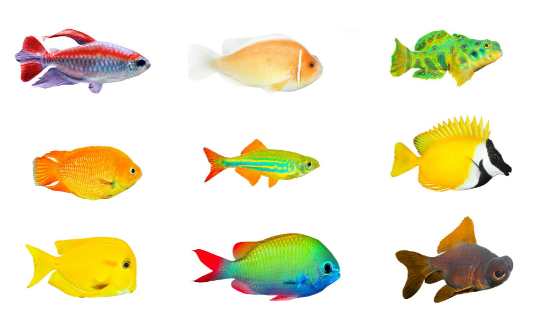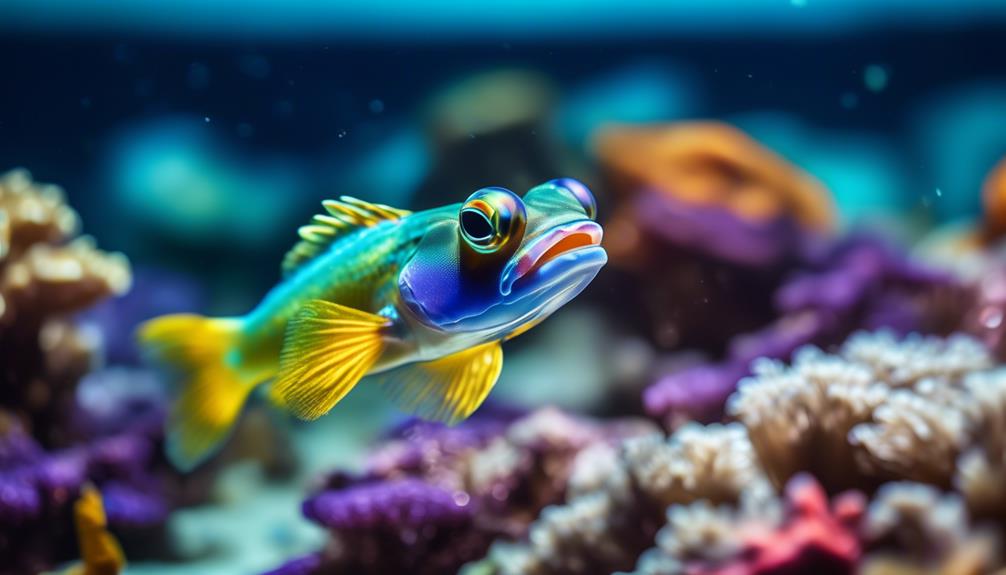
Looking to add a splash of vibrancy and elegance to your saltwater aquarium? Look no further than the dazzling jawfish!
These captivating creatures are a true sight to behold with their mesmerizing body colorations and patterns. But there’s more to these hardy beauties than just their stunning appearance.
In this article, we will explore their unique characteristics, habitat requirements, and feeding habits, among other fascinating aspects. So, get ready to uncover the secrets of the jawfish and discover how they can bring a touch of beauty to your own underwater oasis.
Key Takeaways
- Jawfish are smaller in size compared to blennies and have larger mouths and heads.
- They have dazzling body colorations and patterns, coming in shades of pastel, yellow, blue, green, brown, black, and white.
- Jawfishes are found in the Atlantic, Pacific, and Indian Oceans.
- They are non-aggressive, make excellent additions to most community saltwater aquariums, and spend time arranging the sand and rubble to create the perfect burrow.
Size and Appearance
Jawfishes, smaller in size compared to blennies, boast larger mouths and heads, along with dazzling body colorations and patterns in various shades. These stunning fish come in pastel, yellow, blue, green, brown, black, and white hues.
Found in the Atlantic, Pacific, and Indian Oceans, jawfishes are a sight to behold in any saltwater aquarium. They prefer tanks with a thick layer of sand substrate, where they dig lengthy tunnels for protection.
When it comes to behavior, jawfishes are non-aggressive and make great additions to community saltwater tanks. They defend the areas surrounding their tunnel openings and spend time arranging the sand and rubble to create the perfect burrow.
In terms of feeding, jawfishes are carnivorous and thrive on a meaty and varied diet. With their unique appearance and fascinating behaviors, these hardy beauties are a favorite among aquarists of all levels.
Distribution and Habitat
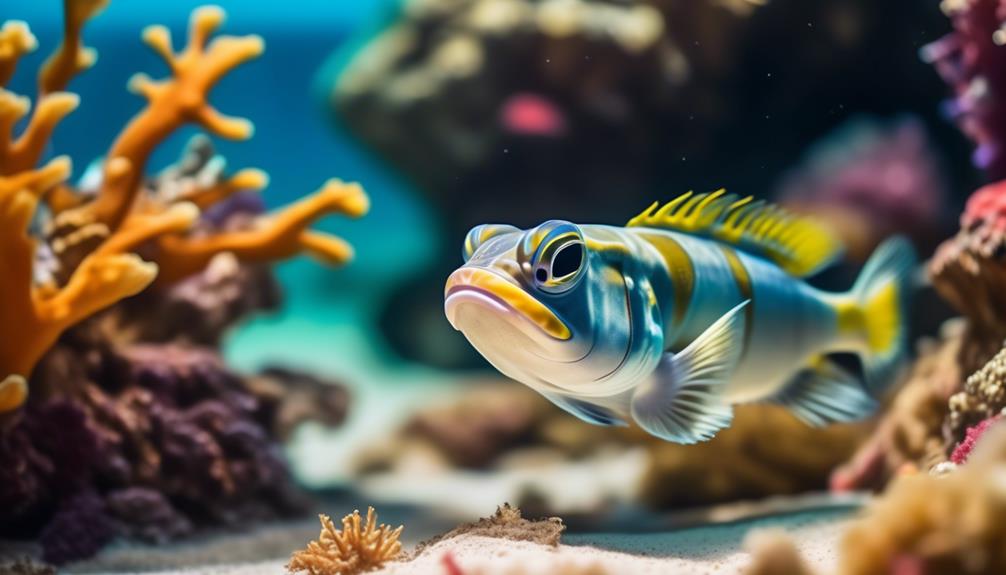
Found in various oceans around the world, jawfishes inhabit a range of habitats that suit their unique needs. These habitats include:
- Coral reefs: Jawfishes can be found in coral reefs, where they make their homes in the sandy areas between coral formations. The sandy substrate provides them with the perfect environment for digging their burrows and hiding from predators.
- Seagrass beds: Some species of jawfishes can also be found in seagrass beds. These habitats offer them protection and plenty of food sources, such as small crustaceans and worms.
- Sandy bottoms: Jawfishes are also known to inhabit sandy bottoms, away from coral reefs and seagrass beds. These areas provide them with ample space to dig their burrows and create their own little territories.
- Rock and rubble areas: In addition to sandy habitats, jawfishes can also be found around rocky and rubble areas. They use these structures to break up their line of sight and create additional hiding places.
Tank Requirements
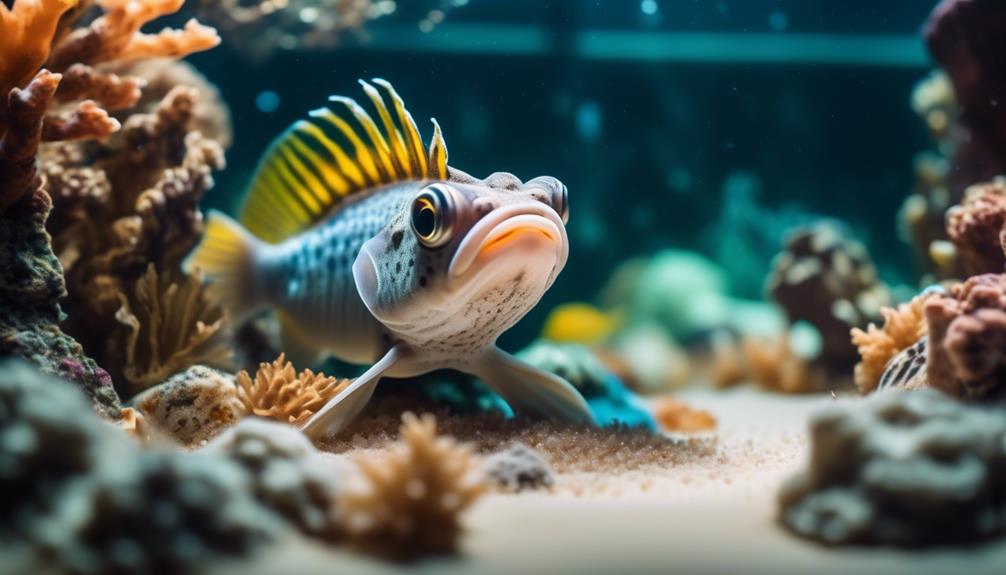
To ensure the proper care and well-being of jawfishes in your saltwater aquarium, it’s essential to consider their specific tank requirements.
Jawfishes prefer aquariums with a thick layer of sand substrate, as they dig lengthy tunnels in the substrate for protection.
It’s advisable to use rock and coral to break up each fish’s line of sight and create a more natural environment.
Additionally, jawfishes should be housed in aquariums with tight-fitting lids to prevent them from jumping out.
These fish are non-aggressive and make excellent additions to most community saltwater aquariums.
However, if you plan on keeping several jawfishes together, it’s important to use rock and coral to reduce aggression.
Behavior and Temperament
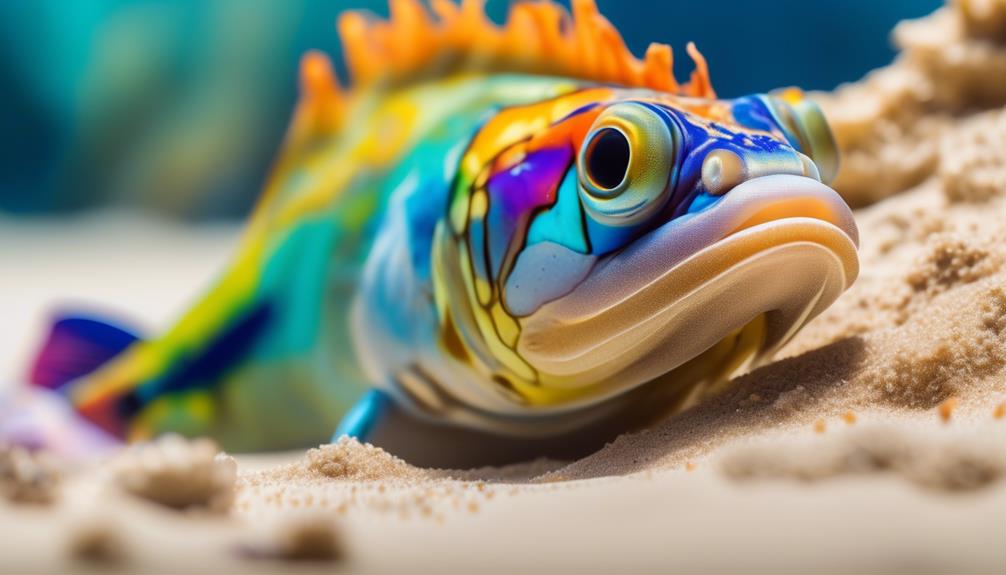
Jawfishes exhibit a peaceful nature and make excellent additions to most community saltwater aquariums. Here are some interesting facts about their behavior and temperament:
- They defend the areas surrounding their tunnel openings, ensuring their territory remains secure.
- Keeping several jawfishes together requires using rock and coral to reduce aggression, as they can become territorial.
- They spend a significant amount of time arranging the sand and rubble to create the perfect burrow, showcasing their meticulous nature.
- Jawfishes are known for their intelligence and active hunting behavior, making them fascinating to observe.
With their peaceful demeanor and intriguing behaviors, jawfishes add a unique charm to any saltwater aquarium. Their ability to create and defend their own territory, as well as their active hunting habits, make them a captivating addition to your underwater community.
Feeding Habits
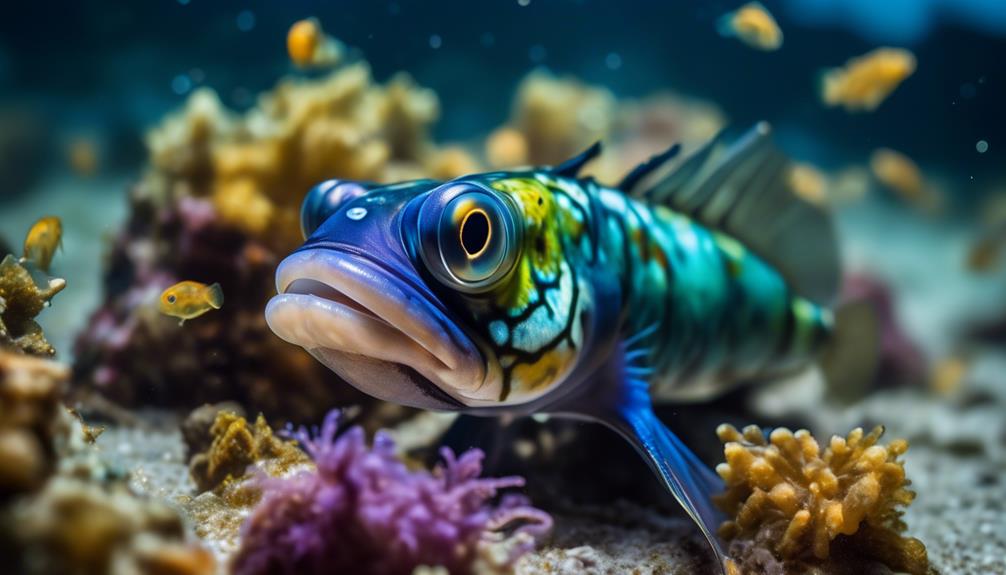
When it comes to their feeding habits, jawfishes are carnivorous and thrive on a meaty and varied diet. They do best when fed small amounts of food such as brine shrimp, krill, and minced shellfish. Using a turkey baster, you can easily feed them these foods, making sure to discharge the food close to their burrow openings.
Jawfishes are intelligent and active hunters, so providing them with a diverse range of prey will keep them healthy and satisfied. It’s important to note that they aren’t picky eaters and will readily accept different kinds of meaty foods. By offering a balanced diet, you can ensure the well-being of your jawfish and witness their vibrant colors and beautiful behaviors.
Reproduction and Parental Care
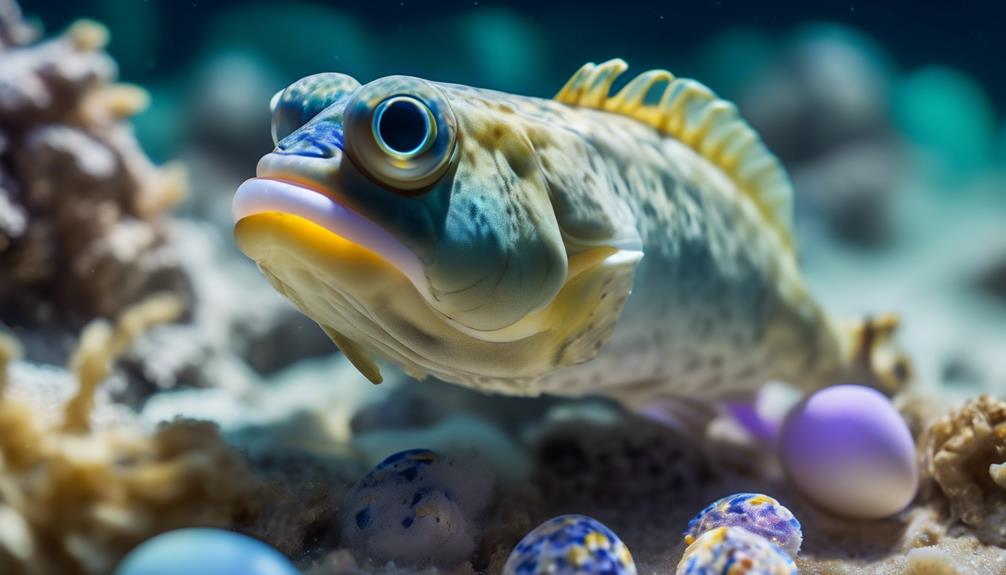
After discussing the feeding habits of jawfishes, it’s important to understand their reproductive behavior and how they provide parental care for their eggs and fry.
Here are some key points about jawfish reproduction and parental care:
- Jawfishes are mouth brooders, meaning that the females carry the eggs in their mouths until they hatch.
- The females lay their eggs in the male’s burrow, and then the male fertilizes the eggs.
- Once the eggs are fertilized, the female picks them up with her mouth and keeps them safe until they hatch.
- The male jawfish guards the burrow entrance, ensuring the safety of the female and the eggs.
Jawfishes are remarkable in their dedication to parental care, with both parents playing important roles in protecting and nurturing their offspring.
Breeding in Home Aquariums
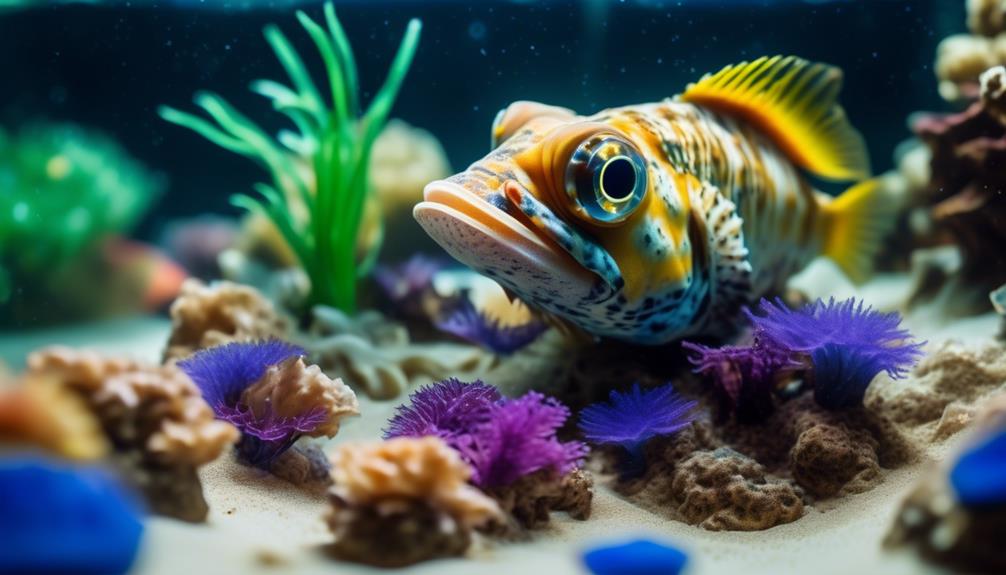
To breed jawfish in a home aquarium, you will need to create a suitable environment and provide the necessary care for successful reproduction. Jawfishes are mouth brooders, meaning the males carry the eggs in their mouths until they hatch. To encourage breeding, it is important to replicate their natural habitat. Maintaining a stable water temperature between 75-80°F and a pH level of 8.1-8.4 is crucial. Additionally, a thick layer of sand substrate should be provided for the jawfish to dig their burrows. To add depth to their breeding requirements, here is a table outlining the key factors for successful breeding in home aquariums:
| Breeding Requirements | Details |
|---|---|
| Water Temperature | 75-80°F |
| pH Level | 8.1-8.4 |
| Sand Substrate | Thick layer for burrow creation |
Suitable Tank Mates
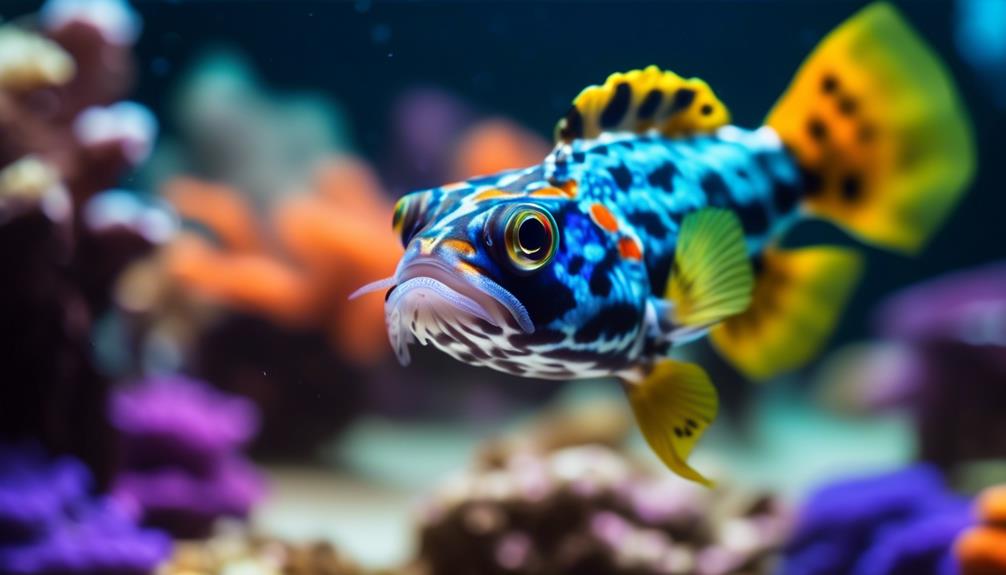
Jawfishes in home aquariums thrive when paired with suitable tank mates that complement their non-aggressive nature and habitat preferences. To ensure a harmonious environment for these stunning fish, consider the following compatible tank mates:
- Clownfish: These colorful and popular fish share similar water and habitat requirements with jawfishes. They’re peaceful and can coexist without any issues.
- Gobies: Gobies make excellent tank mates for jawfishes due to their peaceful nature and ability to occupy different areas of the tank. They also share the same substrate preferences.
- Blennies: Blennies are another suitable choice as they’re typically non-aggressive and can cohabitate peacefully with jawfishes. They add diversity to the tank with their unique appearance and behavior.
- Royal Gramma: These beautiful fish are known for their vibrant coloration and peaceful temperament, making them an ideal choice to keep alongside jawfishes.
Compatible Water Conditions
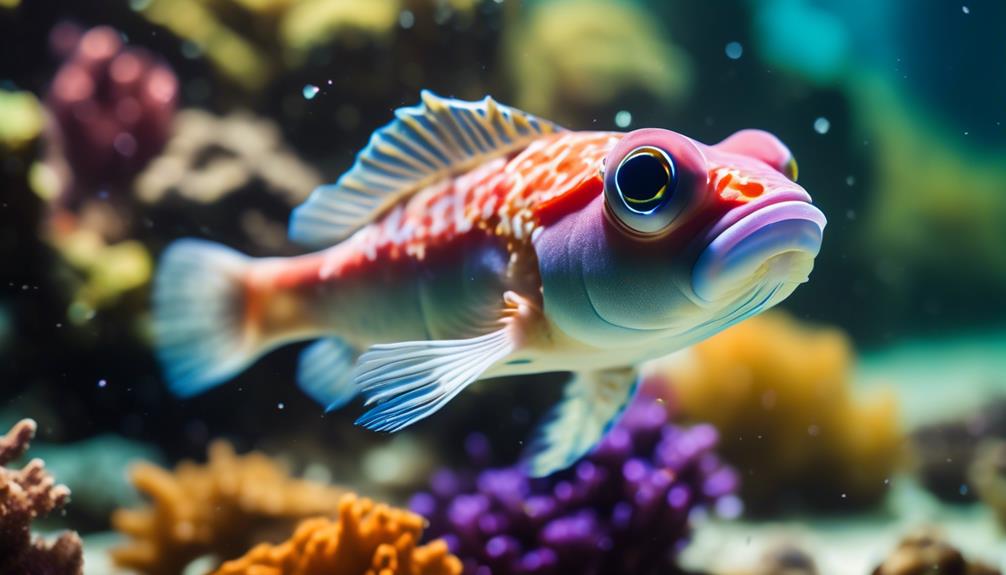
When considering suitable tank mates for jawfishes, it’s important to ensure that the water conditions are compatible for both species.
Jawfishes are saltwater fish and thrive in aquariums with a thick layer of sand substrate. They prefer to dig lengthy tunnels in the substrate for protection and spend time arranging the sand and rubble to create the perfect burrow.
To create a harmonious environment, it’s advisable to use rock and coral to break up each fish’s line of sight. Additionally, jawfishes should be housed in aquariums with tight-fitting lids to prevent jumping out.
Weekly Care Tips
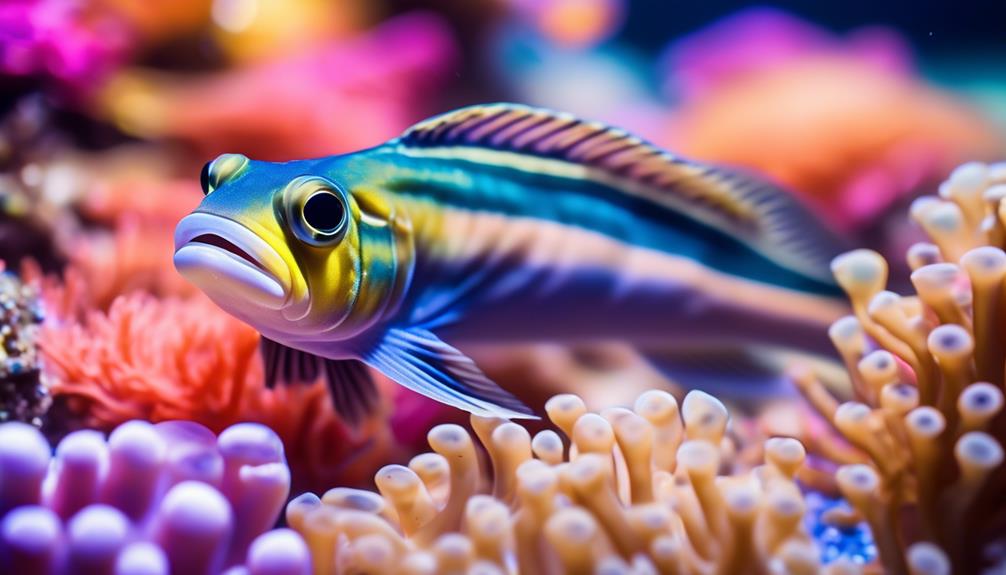
Make sure to regularly perform maintenance tasks for your jawfish aquarium. Proper care and attention will ensure the health and well-being of your beautiful jawfish. Here are some weekly care tips to keep in mind:
- Perform water changes: Regularly change a portion of the water in your aquarium to maintain optimal water quality. This helps remove toxins and replenish essential minerals.
- Clean the substrate: Gently stir the sand substrate to prevent the buildup of debris and waste. Use a siphon or gravel vacuum to remove any accumulated detritus.
- Check equipment: Inspect filters, heaters, and other equipment to ensure they’re functioning properly. Clean or replace any clogged or worn-out parts.
- Monitor water parameters: Regularly test your aquarium water for temperature, pH, ammonia, nitrite, and nitrate levels. Make adjustments as necessary to maintain a stable and healthy environment.
Popular Among Aquarists
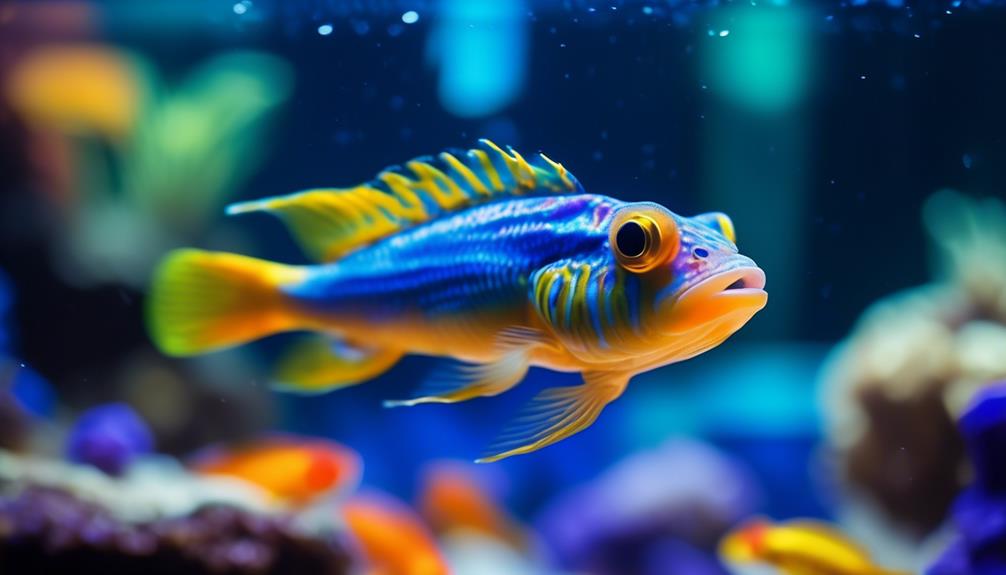
To continue our discussion on the fascinating world of jawfish, let’s now explore why these captivating creatures are highly sought after by aquarists.
Jawfish are popular among aquarists for several reasons.
First and foremost, their stunning colors and patterns make them a visually striking addition to any saltwater aquarium. From pastel shades to vibrant blues and yellows, jawfish come in a variety of beautiful hues.
Additionally, their interesting behavior of digging tunnels in the sand substrate adds an element of intrigue to the aquarium. Aquarists also appreciate the fact that jawfish are non-aggressive and can be kept in community tanks.
Lastly, their hardiness and ability to adapt to various tank conditions make them an ideal choice for both beginner and experienced aquarists.
Frequently Asked Questions
What Is the Average Lifespan of a Jawfish?
The average lifespan of a jawfish is around 3-5 years. They are hardy saltwater fish that require proper care and suitable tank mates. Keep an eye on their behavior and provide a varied diet for their well-being.
Can Jawfish Change Their Coloration and Patterns?
Yes, jawfish can change their coloration and patterns. They have the ability to display different shades of pastel, yellow, blue, green, brown, black, and white, making them even more dazzling and fascinating to observe.
How Do Jawfish Defend Their Territory Around Their Burrow Openings?
Jawfish defend their territory around their burrow openings by displaying territorial behavior. They will aggressively chase away intruders and use their larger mouths and heads to intimidate potential threats.
Do Jawfish Require Any Special Lighting in Their Aquarium?
No, jawfish don’t require any special lighting in their aquarium. They are hardy and adaptable, so standard aquarium lighting is sufficient for their needs.
Are There Any Known Diseases or Health Issues That Commonly Affect Jawfish?
There are no known diseases or common health issues that affect jawfish. They are hardy fish and typically do not encounter major health problems if provided with suitable tank mates and proper care.
What Makes Jawfish and Discus Fish Beautiful and Unique in the Underwater World?
The exquisite discus fish beauty is truly remarkable in the underwater world. Their vibrant colors and unique patterns make them a sight to behold. Jawfish, on the other hand, are known for their interesting behavior and impressive burrowing skills. Both species stand out for their individual characteristics and add diversity to marine ecosystems.
Conclusion
In conclusion, if you’re looking to add a touch of vibrancy and elegance to your saltwater aquarium, the dazzling jawfish is the perfect choice. These hardy beauties boast stunning appearances with their mesmerizing body colorations and patterns.
They’re popular among both beginner and experienced aquarists due to their unique characteristics and ease of care. With suitable tank mates and proper water conditions, you can bring the beauty of these captivating creatures into your own aquarium.




